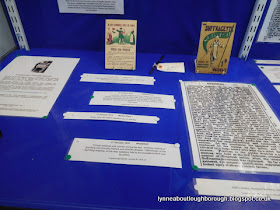This display was researched and arranged by the newly-formed Leicestershire Labour History Society, and the unveiling timed specifically to coincide with the passing of the Representation of the People Act, 1918. This Act decreed that all men over the age of 21 would be granted the vote, as would women over 30, provided they held property to the value of at least £5, or were married to a man who did.
There were, of course, many things that lead up to the passing of this Act, including the First World War, during which whilst men were fighting in the trenches, women were working in munitions factories, as well as on the trains, trams and buses, and in other industries which were previously regarding as men's roles. Also, as part of the women's suffrage movement, women were campaigning to be allowed to vote.
The exhibition in the public library starts with the early days suffrage, possibly around 1875, and follows the progress of the movement, form early meetings in the Town Hall, to later involvement of some Loughborough women.
The opening of the exhibition began in the Charnwood Museum, in front of the model suffragette, and moved on to the public library. Many members of the Leicestershire Labour History Society were present, along with other interested people, and the exhibition was declared open by Lord Willy Bach, Police and Crime Commissioner for Leicester, Leicestershire and Rutland.
I've put a few photos from the event below, but do pop along to the exhibition if you can - it's well worth a read.
Last week I attended a fascinating talk given by Caroline Sharpe (King) about the Loughborough Carillon. After the initial discussions over the pronunciation of the word "carillon" Caroline told the meeting all about her tour of the carillons in the UK, which she undertook when she became our carilloneur in 2008. Apparently, there are 15 carillons in the UK, and Caroline, along with some of her relatives, visited and played quite number of these.
She also explained how the instrument works, and how to interpret the music that is written for it. Unlike playing a piano or an organ, playing the carillon requires a good deal of strength and is a great workout!
There are regular carillon recitals during the year, given by Caroline, and special performances during the week surrounding 22 July, the anniversary of the opening of the Carillon, and on Remembrance Day. The sound of the bells rings out around the town, and can be heard from quite some way away.
 |
| Alice Hawkins the day after unveiling |
You are welcome to quote passages from any of my posts, with appropriate credit. The correct citation for this looks as follow:
Dyer, Lynne (2018). More on suffrage and the carillon. Available from: https://lynneaboutloughborough.blogspot.com/2018/02/more-on-suffrage-and-carillon.html [Accessed 11 February 2018]
Take down policy:
I post no pictures that are not my own, unless I have express permission so to do. All text is my own, and not copied from any other information sources, printed or electronic, unless identified and credited as such. If you find I have posted something in contravention of these statements, or if there are photographs of you which you would prefer not to be here, please contact me at the address listed on the About Me page, and I will remove these.
Thank you for reading this blog.
Lynne


























No comments:
Post a Comment
If you have found this post interesting or have any questions about any of the information in it do please leave a comment below. In order to answer your question, I must publish your query here, and then respond to it here. If your information is private or sensitive, and you don't wish to have it on public display, it might be a better idea to email me using the address which is on the About Me page, using the usual substitutions: if you take the email route, our conversation remains private, and is not published on the blog. Thanks for reading the blog.